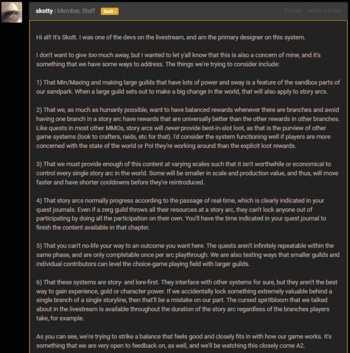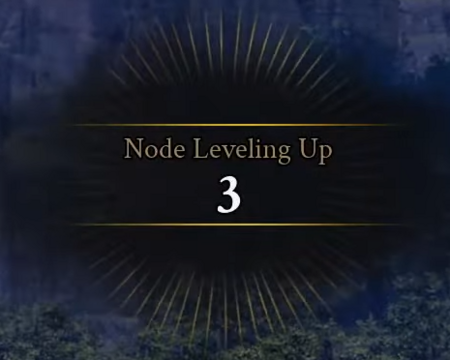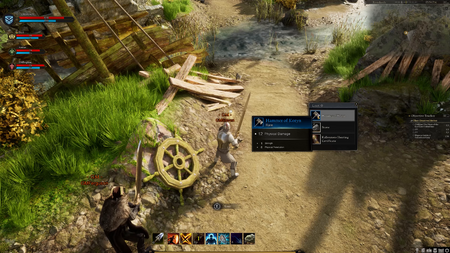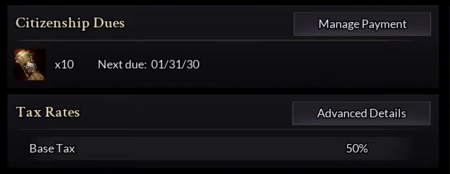Node advancement
Citizen and non-citizen player activity (questing, gathering, raiding, etc.) within a node's ZOI counts toward that particular node's advancement (progression) to a higher node stage.[2][3]
The advancement of a node unlocks its unique content, which comes at the cost of locking out an increasing ring of neighboring nodes from progressing to the next stage.[4]
- Nodes advance to the first stage quickly. This enables NPC services such as vending or banking items.[5]
- The more advanced the node is, the larger its ZOI becomes.[6]
- Less advanced nodes (referred to as vassal nodes) that fall within a more advanced node's ZOI can still gain XP, but must remain at a lower advancement stage than the dominant node.[7]
- The vassal system begins when a node hits Village (stage 3), but neighboring nodes starting from Expedition (stage 1) also block the growth of their immediate neighbors.[8][9]
- Certain quests, such as story arcs, may not be able to be turned in after a node has advanced.[10]
- The territory expansion algorithm takes into account the nearest coast, neighboring nodes, and the heatmap of players in surrounding areas over the last weeks or month.[11]
- Due to the way the progression algorithm calculates territorial (ZOI) expansion during node advancement, there is a small possibility that two nodes of the same stage end up being close to each other.[12]
- The way that the algorithm expands the territories takes into account a few things: One it takes into account the coast like where's the closest coast. Two it takes into account the neighboring nodes so it can take over and essentially vassal state those nodes, but what's more important is essentially the initial population based on like how players choose their races. Because we have nine different races and four different starting points that branch out, each server's population density is going to dictate essentially the first few nodes that are highly populated and then that initial seed is what's going to determine the node structure as it moves inland into the into the world essentially; and based on the performance and successes of different sieges will determine which nodes that got locked out from the previous the initial advancements what nodes can now be available to advance further. So I really think that with so many variables that are present in the equation of how nodes advance and stay existing with the more variables you have, the higher likelihood there is for there to be a significant diversion in world progression.[11] – Steven Sharif
- Normally the algorithm that's applied to the node territorial expansion will prevent significant nodes from being in close proximity to each other... There could be a perfect storm where all of the algorithmic progression of territory leads to having these nodes very close to each other because there's certain requirements that should that need to be available to satisfy node vassal takeovers; and it's possible that two nodes would never take each other over as vassals and end up close together and spanning their territories in opposite directions: The Tale of Two Cities thing.[12] – Steven Sharif
- A node does not receive XP from the nodes within its ZOI until these nodes have reached their cap.[7]
- Node experience gain opportunities will be equitable across the four node types.[14]
- Different people have different resources invested in nodes progressing and it would be a little "gamey" if you could know exactly what was necessary at that point because that would disincentivize people from participating.[15] – Steven Sharif
Node advancement spawns a series of animations and visual effects (within the footprint of the node).[16][2]
- Players within the node are teleported to a safe location, likely a respawn area near the node.[16][17]
- Supplies will spawn around the node and system driven caravans are spawned to bring these supplies into the node. These caravans are not able to be attacked.[16]
- NPCs will begin construction activities.[16]
- Players outside the node will see the new facade of the node pop into existence as the node advances in stage.[16]
- The Development Area of a Node is where civilization will appear as the Node advances. As the Node Stage increases, different buildings, NPCs, and services will become available in the Development Area. The higher the Node Stage, the more complex and populated the Development Area becomes. Development Areas will also vary depending on the Node Type - Economic, Military, Scientific, or Divine.[2] – Margaret Krohn
Node stages
Nodes advance by collecting experience from the actions of players nearby. As players complete content inside of a Node’s Zone of Influence (the area around the node), they contribute that experience toward the Node’s development. The experience given to the Node may then be modified based on certain Events and Accomplishments. When a Node reaches the experience required, it undergoes the process of advancing to the next stage. There are a few exceptions where a Node cannot advance even though it has the required experience - most commonly, a Node can not advance if a Node is a Vassal of another Node and would advance to the same stage as its Parent Node.[2] – Margaret Krohn
Nodes have seven (7) stages of advancement, with experience thresholds for each stage. When a Node reaches the experience required for its current stage, it advances to the next stage.[18]
| Node stage.[3] | Symbol | Alternate name.[19] | Timeframe to advance.[3] | Player housing.[20] | |
|---|---|---|---|---|---|
| 0. | Wilderness | - | |||
| 1. | Expedition | Crossroads | Few hours | - | |
| 2. | Encampment | Camp | Many hours | - | |
| 3. | Village | - | Few days | Small houses | |
| 4. | Town | - | Many days | Medium houses | |
| 5. | City | - | Few weeks | Large houses | |
| 6. | Metropolis | Metro | Many weeks | Mansions |
Vassal nodes
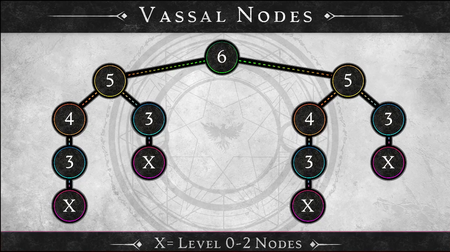
This vassal mode structure tells you what it looks like for a sovereign at a level six metropolis stage; and what it can control at a maximum vassal network is two level five nodes, of which a level five node can control one level four and one level three as direct vassals; and then the four can control a three; and every three can control a one or a two. Now if the three gets removed through siege, the one or the two is removed as well. So that's an important distinction between the three's vassals, which technically isn't really a vassal relationship because there's no citizenships possible. Those vassals don't exist between three and X, but they do exist between four and three, five and four, and six and five. And what this also allows is that because there are 85 nodes that are within the world, we have a buffer zone of about 20 nodes that lives in a max server state. So if you had maximum five metropolises form in a world, you will have a number about 20 nodes that can live alongside those metropolis networks; and when or if a metropolis falls, that extra cushion of nodes around the five metropolis structures allows for the map to be redistricted in a way that is unique. It doesn't mean that one of the fives is just going to pick up where the last six left off and form the same exact metropolis structure. From a territory perspective it has ancillary nodes to play with and expand towards that redistricts the map, so that if a metropolis falls there's a significant difference in the layout of the world and the layout of these almost nation-like territories.[21] – Steven Sharif
Village (stage 3) or higher nodes enslave nearby nodes, converting them into vassal nodes.[18][9]
- A Metropolis (stage 6) can control up to two City (stage 5) nodes. A City (stage 5) can control one Town (stage 4) and one Village (stage 3) node. A Village (stage 3) can control an Encampment (stage 2) or an Expedition (stage 1). If the Village (stage 3) gets destroyed through a siege, its dependant Encampment (stage 2) and Expedition (stage 1) nodes are also destroyed.[21]
- There is a layer of intricacy between how the neighboring nodes advance and what potential parent structure they have in the vassalship tree.[22] – Steven Sharif
- Vassal nodes gain benefits from their regent node (also referred to as sovereign node or parent node) even if the node type of the parent is different to the vassal.[23][24]
- It is not a bad thing to be vasseled, it is a good thing to be vasseled. It brings many benefits from the Sovereign, which is the ultimate parent of that vassal network down to the vassal node itself; and it allows that vassal node to even live outside of its normal mechanics. You get to adopt some of the benefits that the node type of your sovereign is, even if your node type as a vassal node isn't the same.[24] – Steven Sharif
- Regent nodes collect taxes from their vassal nodes. These taxes cannot be taken by the mayor or other players.[26]
- Vassal nodes must remain at least one node stage below their parent node.[18]
- Neighboring/Adjacent nodes from Expedition (stage 1) upward block the growth of their immediate neighbors. This was intended to be tested in Alpha-1.[8][9]
- Vassal nodes first apply any experience earned to their own deficit (see Node atrophy). It then applies excess experience earned to its parent node.[2]
- If the parent node advances, the vassal is once again able to advance.[18]
- Vassal nodes give excess experience to their parent node and may have their own vassals; so long as they fall within the parent node’s zone of influence.[26][18]
- If a node is capped and is both a vassal and has its own vassals, any experience earned from itself or its Vassals is first applied to its own deficit. Experience beyond that is then sent to its parent node.[2]
- When the vassal reaches its cap it overflows experience up to the parent; and so it can be very good early on for parents to get vassal nodes that are very productive- that have a lot of traffic.[26] – Steven Sharif
- Vassals are subject to the government, alliances, wars, taxes, and trade of their parent node, and are able to receive federal aid from them.[18]
- Vassal nodes cannot declare war on their parent node or any of their vassals.[18]
- Citizens of vassals are bound by the diplomatic states of the parent node.[18]
- If a Node is a Vassal Node and is capped from advancing further, it first applies any experience earned to its own deficit (see Node Atrophy section), and then applies excess experience earned to its Parent Node. If the Parent Node advances and the Vassal is able to grow, it becomes uncapped. If a Node is capped and is both a Vassal and has its own Vassals, any experience earned from itself or its Vassals is first applied to their own deficit. Any experience beyond that is then sent to its Parent Node.[2] – Margaret Krohn
Adjacent/Neighboring nodes
Adjacent nodes (Neighboring nodes) starting from Expedition (stage 1) may block (lockout) the growth of their immediate neighbors.[8][9]
- Vassal nodes must remain at least one node stage below their parent node.[18]
- Encampment (stage 2) and Expedition (stage 1) nodes are technically not vassal nodes as they do not support citizenships. If their parent Village (stage 3) node is destroyed by a node siege, these nodes are also destroyed.[21]
Zones and progression
Dungeons, Raids, World bosses, Mobs, Quests, Events, Resources, Narratives and other content within a node's ZOI will have a diverse level range; but will scale with the advancement of that node and its racial influence.[27][28][18]
- Portions of the spawn tables (for mobs and resources) are static and other portions are dynamic and adapt to node development.[29]
- We don’t have a strictly level 25 zone. Instead, that zone might have some level 10 creatures near the road, some level 20 creatures deep in the forest, and some level 30 creatures up the mountain. These ratios will change based on the Nodes that inform them, becoming generally more dangerous as the Node grows. All this civilization attracts the attention of Things-That-Should-Not-Be. This does not mean that wilderness areas are safe, by any means. Some may be safe-er, but all will have dangers that even the most experienced traveler needs to watch out for.[30] – Steven Sharif
Node simulation
This representation does show 111 nodes as part of this particular simulation. I'm not sure what the tick frequency is on this video. It might be something on the magnitude of like every second is probably 12 to 24 hours. So over time you start seeing these larger node systems building up to eventually where you might see Cities and Metropolises after some period of time; and what this allows the design team to do from a tools perspective, as they simulate this idea of how the world is going to progress, is it gives an opportunity to see strange happenings or something that we couldn't necessarily predict but was a possible outcome based on the variables present.[31] – Steven Sharif
The developers have created a simulation of node interactions in preparation for Alpha-2 deployment of the node system.[31]
- This simulates how nodes advance and expand their zones of influence over surrounding nodes.[31]
You can show the initial territories on the Verran map of what these particular nodes have governance over, or their Zones of Influence as we like to call them... As the simulation of this begins to advance and nodes begin to expand their territory and they begin to take over nearby nodes as a result of their of their growth, you start to see these power level ratings that are applied here on specific nodes that determines what type of takeover power it has and and what it pushes back against for other nodes that are looking to take over new territory as they advance.[31] – Steven Sharif
- It also simulates events, such as NPCs attacking and disabling certain node buildings and services. Failure to successfully respond to these will reduce the node's "health ticker", which will slow down the XP gains from the node.[31]
It also simulates events: So each of these nodes will have a health ticker: when that health ticker is impacted it'll stop gaining power or gaining or slow down in its gaining of experience; and that's because certain events can affect a node by disabling certain services, disabling buildings. Players don't respond to that horde of zombies that have come out of the nearby ravine then those zombies can attack stables, they can attack service buildings, and prevent particular types of quests or activities and services from happening until it's repaired.[31] – Steven Sharif
- Node sieges are simulated, with successful sieges destroying the nodes, and where unsuccessful sieges won't destroy the node but may result in disabled buildings or services, similar to events.[31]
It simulates the sieges if a particular node has a certain frequency that's set where we want to see randomization of how nodes get affected by sieges. Sometimes they'll be destroyed in the simulation. Sometimes they'll have disabled services again, similar to an event, because they didn't succeed necessarily at sieging the node but they did succeed at disabling some of the buildings as part of that siege.[31] – Steven Sharif
- It simulates what outcomes may happen in the live game as a result of player activity, such as splitting up a particular ZOI across a waterway, or having territories expand out to islands or across continents.[31]
It simulates what players could potentially do as well when the game goes live; and that might include things like splitting up a particular Zone of Influence across a waterway, having your territory expand out to an island, or across continents. These are these are the types of things that we want to see players do eventually obviously but this tool provides the design team the opportunity to see it repetitively and over a fast period of time so they see these different types of outcomes.[31] – Steven Sharif
World manager
The World manager is an algorithm in Ashes of Creation that controls dynamic world elements. It acts as both a throttle and an incentive system for various activities to ensure certain parameters are within acceptable thresholds.[32]
- A world manager is a technical term to define a server process that lives alongside the game server; and when the game server needs to do things- communicating with other game servers within that grid- it tells that manager and that manager sends it down to the appropriate server.[33] – Steven Sharif
- Prices of glint.[34]
- A heatmap of experience being gained to apply to node advancement.[34]
- The territory expansion algorithm takes into account the nearest coast, neighboring nodes, and the heatmap of players in surrounding areas over the last weeks or month.[11]
- Due to the way the progression algorithm calculates territorial (ZOI) expansion during node advancement, there is a small possibility that two nodes of the same stage end up being close to each other.[12]
- Transit of resources and goods between regions to drive quest rewards for nodes.[34]
- For example if you know iron is being used as a raw resource for a specific crafting path that might drive up the price of mithril or silver; and that will incentivize the market to course correct a little bit. The idea is to provide soft incentives that help to alleviate the demand and also to prop up the supply that might not be present from the economic systems.[34] – Steven Sharif
Population based scaling
The prices that NPCs sell items for will scale based on the economic activity on a server. Prices will rise to combat inflation and fall as a population diminishes.[35]
The node system allows the developers to scale the experience needed to level a node and the attrition that affects a node based on activity.[35]
Things that NPCs buy and sell scale based on the economic activity that exists on that server... As inflation rises, prices rise and everything ends up being equal, even though there might be a couple of extra zeros. So that can go up and it can also go down so as a population leaves, things become less expensive and players don't have to do as much to earn that. On the other side of things we look at the node system and the node system is set up in this really flexible way that allows us to scale the experience needed to level a node and the attrition that delevels a node to scale based on activity too. So it's just a matter of adjusting a couple of constants and that goes up and down and the server can watch it and change those on the fly as it needs to.[35] – Jeffrey Bard
Loot tables
- Mobs drop glint, Items, and crafting materials in preference to gold.[37][38]
- Glint is not bound to a specific region and can be also dropped by players on death as stolen glint, based on applicable death penalties.[39][40][41][42][37][43]
- The rarity of glint increases with the mob's level.[44]
- Loot tables are disabled for player controlled monsters.[45]
- There is a small RNG chance of looting rare and legendary items or crafting materials from mobs based on the level, status and type of mob. This also applies to harvesting resources with a gathering profession.[46]
- Experience debt decreases the drop rate percentages from monsters.[47]
- Loot (loot tables) from world bosses or dungeon bosses has a small RNG chance of dropping gear (completed items).[48][49]
- There is a much higher chance that materials and unique recipes are dropped that can be used to craft items of equitable value.[48][50][51]
- Legendary equipment is only dropped by Legendary world bosses.[52]
- Loot tables will likely not be affected by weather conditions.[54] This was previously listed as a possible effect.[55]
- There won't be specific loot drops for artisans.[56] Previously it was stated that master gatherers may have the ability to "spoil" a boss' loot.[57]
- Q: Can only one gathering artisan harvest resources from a single boss, or can multiple different artisans harvest different parts from a boss for different resources? For example, a lumberjack gets a special wood from Tumock's tree weapon, while a herbalist gathers the flowers from that same tree.
- A: We don't have the concept of harvesting from bosses. NPCs follow a reward table format, where those reward tables are global. They're not unique to particular players. So, once the NPC is vanquished, you have access to the loot container that is its corpse; and it has a static value of either materials or items that get dropped; and whatever the party loot settings are that you might be a part of, or if you're a solo player you will be able to recover those things.[56]
Nodes
Nodes are a pre-set location, wrapped in a zone of influence, in our world that can form into towns of different sizes. These sizes range from a small camp to a sprawling metropolis. The size of the towns depends on the contribution by players and how far they’ve advanced the Node. Players do not create the footprint of a Node, but within that footprint they do have the ability to own land. Players who are part of the government for a specific Node will have the ability to modify building types and services further, but for the most part, a Node will grow along its own specific path (think about this more as NPCs building these towns out, rather than PCs individually putting buildings and walls up). A Node’s contribution area is larger than the actual town itself, allowing for players to adventure while building upon the town. We call the contribution area the Node’s “Zone of Influence,” and it’s the area where players help to advance the Node they are in.[59]
Encompassing each server are carefully placed points of development called Nodes.[3] There will be 85 regular node locations at launch with 15 additional castle nodes (5 castles x 3 castle nodes each)[60][61][62] for a total of 100 nodes.[63]
- Previously the developers estimated 103 regular node locations with 15 additional castle nodes for a total of 118 nodes.[18][64][60][61][62]
- This decrease in node count does not affect the amount of available player housing, or the estimated server capacity.[65][66]
- We have moved from a 103 nodes to 85 nodes; and there's a few reasons for that. One, when we were doing the calculations behind how- in Alpha 2 and in the game- we want these vassal structures to exist, we had more nodes than what felt meaningful and we wanted to condense some of that those curated story arcs and hooks into the environment and realm around the areas to be more bountiful at a lesser node value: meaning bringing down the node count so that we can increase the richness of each of those nodes more than what was at 103.[63] – Steven Sharif
- There were 9 node locations in Alpha-1.[67]
- Node locations are subject to change prior to Beta-1.[67]
- Nodes have emblems that can be placed on flags and certain types of armor.[68][69]
- Nodes are the heart of the world, they create the ebb and flow of life. At their core, Nodes are pre-set points in the world, wrapped in a Zone of Influence and surrounded by geographic areas that change over time based upon player participation. The world map is divided into regions, with each region containing multiple Nodes. As a Node advances, it influences the types of content within itself and the surrounding areas. Players do not create Nodes, but if they are a part of the government for a specific Node, they have the ability to influence diplomacy, and modify building types/construction and services within that Node.[18] – Margaret Krohn
Node atrophy
Nodes accumulate an experience deficit each day based on the node's level, called node atrophy. The deficit is subtracted from any experience earned that day. If any deficit remains, then this is subtracted from the node’s experience pool.[2]
- An atrophy system may be implemented, where accumulated atrophy points will progressively disable services within a node. The node may be destroyed if a significant points threshold is reached.[12]
- There are intrinsic problems with reducing a nodes level as opposed to removing the node and it may be possible I'm just gonna say now that we don't actually atrophy nodes to delevel but rather accrue atrophy points that must be replenished over time; and if not it begins to disable services and further compound the atrophy problem; at which point when it reaches a certain atrophy point then the node would just disappear.[12] – Steven Sharif
Node layout and style
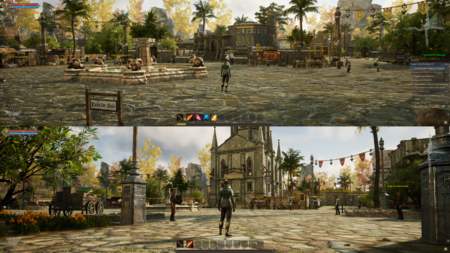
The layout and architecture within a Node’s development area are determined by influential race. For example, a stage 3 Node with the majority of player contribution being Py'rai would have a Py'rai village with Py'rai architecture. Most NPCs would be Py'rai elves, and offer questlines within the Py'rai narrative.[18] – Margaret Krohn
Each player’s contributed experience is flagged with their character race and other identifiers. When a Node advances, the race with the highest experience contribution determines the Node’s style and culture. This style and culture change can happen at every Node Stage. For example, if a Node advances to Level 2 - Encampment Stage and 51% of all experience was earned by Ren’Kai players, the Node will be a Level 2 Ren’Kai Node. If that same Node advances to a Level 3 - Village Stage Node, but the Py'Rai contributed 62% of all the experience earned, then the Node will be a Level 3 Py'Rai Node.[2] – Margaret Krohn
Node layout and style is determined by several factors:[70][71]
- The way that the node system is built is that they can exist across a spread of 18 biomes, but at the same time have to represent the cultural influence of these cultures that are intrinsically a part of a specific biome.[72] – Steven Sharif
- Environment (biome) and location of the node.[72][70][71]
- Nodes will adjust the local topography to fit the aesthetic and mechanical requirements of the node.[73]
- Currently the way that the platform system is set up, is it's capable of adjusting the topography of the node's footprint, regardless of the surrounding terrain. So the reason for that is we want to have flexibility in the presentation of the node's layout and how it is essentially both from an aesthetic standpoint as well as a mechanical standpoint with node sieges- how it's constructed and that construction should have the ability to take on a variance of different types of topography. So it shouldn't be dependent on the surrounding area. Now that's not to say that the surrounding area isn't going to have some influence over. So for example... we're experimenting a little bit with the platform tech and putting up a node up against the side of a mountain or on the edge of a cliff or something that has a beautiful vista. Those are things that we're going to test out obviously as we continue to work on the node tool and how that platform system works, but the idea is to have the node independent of the surrounding terrain.[73] – Steven Sharif
- Some parts are determined by the area it's in. Some parts are determined by the type it is. Some parts are determined by the race it is; and then the rest of it is determined by the mayor.[71] – Jeffrey Bard
- Race that contributed the highest percentage to the node's advancement will alter the racial appearance of its buildings, NPCs, and props.[74][75][70][2][71][76][77]
- All nodes, whether they're associated with a castle or associated with normal node structure, has cultural influences that replicate over to the buildings that are produced and the NPCs that are present.[79] – Steven Sharif
- The rest is determined by the node's mayor.[71]
- It should be possible for a node to complete several building projects within a mayor's one month term in office.[80]
- Q: How long would you say it will take players on average to fill/build up a node completely from wilderness to metropolis?
- A: It's one thing to get a node to a certain level: it's another thing to develop the node; and I can't really give you an on-average expectation, because there's a lot of variables at play. There's how many citizens does the node have attracted to it; what's the type of traffic that the node is attracting to it based on things like its tax rates, or the specialization that it chose to spec into, based on the building types it's chosen to build. All of those things are variables that can affect the quote-unquote "average build-out time" of a particular node. So it's difficult to give you an average when there's so many variables along those lines. But the idea is that if there is a particular project that players are interested in in developing based on the node stage, that they would have the ability to complete several of those projects as within a single term of a mayor; and a term of a mayor is one month.[80] – Steven Sharif
Cultural influences
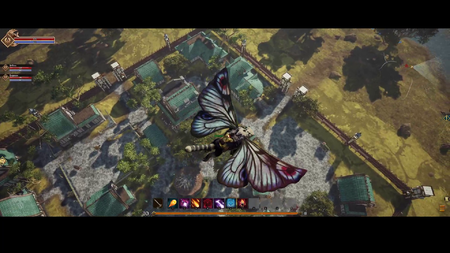
We have essentially sets that exist across all races; and each race that dons those armor sets is going to have their own racial influence on the presentation of those particular sets. So that's something that's unique in how each of the races get diversified. Additionally, the more that one particular race contributes to a node's development, it's going to manifest in that particular node's architectural influences. You're going to see the architectures of those races become manifest within the nodes as well: That's another way that we diversify each race and we present each race's culture in the game as through those architectures, through those props that exist, through the tailoring of the armor sets that the NPC might wear, to the different factions that exist. Factions will have their own affiliation with different races as well. Each race will also have some different nomenclature when it comes to the lore, or comes to locations in the world. They're going to have their own language influences as well: The way they speak is something that's going to be distinct between races; when you have dialogue trees with particular NPCs. So all of those things really go into setting an immersive world where the cultures have their own identity.[74] – Steven Sharif
Cultural influences manifest in many ways, from node and gear aesthetics to NPC languages and lore.[74][82][2]
- Gear appearance of certain armor sets is influenced by the player's race.[74]
- Node layout and style is influenced by the race that contributes the most to that node.[74]
- There is an attrition and that attrition on experience and influence is heightened based on the performance of the race in the world. So if all these nodes are Orc nodes then their attrition rate is very high to compete with the cultural establishment of new nodes because they have more influence in the world and a popular opinion is against them in their outlying regions that they do not have influence in.[83] – Steven Sharif
NPC racial interaction
- NPCs will react differently to different character races.[84]
- Languages will be distinct between NPC races and in the lore.[74]
- Certain quest givers and NPCs may only be present at nodes with certain cultural influences.[85]
- Depending on the cultural influence of the node activates certain types of quest lines and/or sponsors. Some of those are shared, some of those are general. Some of those relate to a progression path that is a first time user experience. Those will be constant across all culture types. Some of them, however, are predicates that spawn when certain story arcs and/or events, or commissions or buy orders become present within the node; and those might change based on the cultural influence of the node. So there is a separation between those populations.[85] – Steven Sharif
Taxation
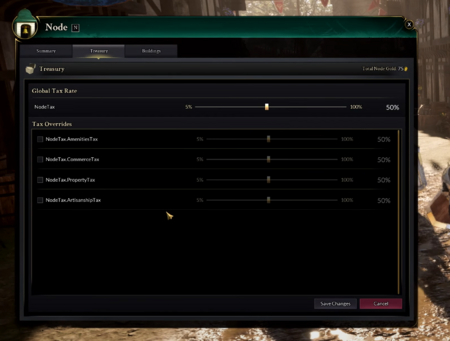
As the node levels up, you're gonna get access to deeper controls on the taxes, so that you as a Mayor can incentivize players to come to your node to do certain things. If you're a node that loves smithing, you're probably going to want to lower your taxes on artisanship to incentivize players to be here. But then you might want to drive up taxes on other avenues that players aren't necessarily coming to your node for, but are using out of convenience.[86] – Chris Justo
Mayors are able to set a generalized node tax rate as well as overrides for different activities within their node. Mayors gain additional taxation controls as their node advances.[86][87]
- Amenities tax override.[86]
- Artisanship tax override.[86]
- Commerce tax override.[86]
- This may include taxes that apply to tavern games.[88][89]
- Property tax override.[86]
- Freehold property taxes scale according to the number of freehold building permits issued for that freehold.[90][91][92]
- Citizenship dues and property taxes scale based on the stage of the node when a player became a citizen.[93][94][95][96][97]
- The goal is to exert financial pressure on node populations by making taxes increasingly expensive as nodes advance, rather than putting in place hard population caps.[95][96]
- Node tax rates will be visible on the world map by hovering over a node location.[98]
- Tax revenue only goes toward funding node development. This cannot be withdrawn by the mayor or any other player.[26][92]
Regent nodes take a cut of taxes from various activities that occur within their vassal node structure.[26][99]
- This tax doesn't necessarily impact the individual citizen, because citizen's tax levels are determined by their node, but the node's finances are affected by the taxation levied by its parent nodes.[99]
Announcements and notifications
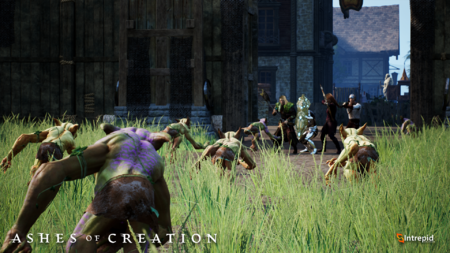
Enemies can only really grow stronger as the node grows, becoming outposts essentially for exiled or rivals of the existing order.[102] – Steven Sharif
There will be local, regional, or global (server-wide) announcements/notifications of important events.[102][103]
- Castle sieges.[103]
- Node sieges.[103]
- Legendary world boss spawns.[103]
- Mob attacks and Monster coin events.[104][105][106]
- Dungeon opportunities.[106]
Event notifications will utilize different methods depending on the stage (scope and level) of the event.[102]
- Local events
- Local events (such as caravan PvP)[107][108][109] may prompt players via the UI asking if they wish to participate or not.[102]
- Other local events may offer audible or visual cues without any UI notifications.[102]
- Local events that have not been addressed may start to expand regionally or even globally.[102]
- One important thing to note about events in general is notifications are sent to the players. Players can opt into these events in a similar way that you would into a quest. You're going to be presented with a 'would you like to participate' but they might not always be that way. You might hear trees falling in the forest and that may be an audio cue to tell you something's happening over there. It's out of the ordinary. This is not normally an audio cue that I hear in this area and i'm gonna go investigate that thing. So it might not just be always that UI window represented with a 'participate or not' but I'm going to go investigate and in that sense it could be stage driven. So you might have the more local stage where it is just the visual or audio cues and you get to go participate in that stage; and then when it advances, or if you don't answer the problem in time, then it starts to expand regionally and then it might send out particular notifications to either citizens of the node from which it falls under its purview or even broader than that. It could be global driven events and then it could have things that are are visual cues that are really big like a giant blizzard that's affecting the zone, because the event hasn't been addressed; and that can affect the crop rotations or it can affect passages and roads and how caravans move. There's a lot that the predicate system informs to the event system and then the event system reacts to those types of predicates.[102] – Steven Sharif
- Node-based events
- Certain node-based events will be broadcast to node citizens,[102][106] others, such as caravans, will not be announced and will instead rely on player word-of-mouth.[103]
- Node advancement notifications will be broadcast depending on the node's stage.[110]
- Expedition (stage 1) and Encampment (stage 2) nodes will announce within proximity of the node.[110]
- Village (stage 3) nodes will have region-wide announcements.[110]
- Town (stage 4) and higher will likely broadcast world-wide.[110]
- New citizens of a node may be announced in a dedicated node citizen chat channel.[111]
- Election notices will be mailed to the accounts of citizens.[111]
- Whether it be like a siege or a triggered event against a city or like a unique dungeon opportunity... those types of things are going to involve notifications. Especially to the citizens of the city; where you'll be informed of an impending event. Basically it will give you time.[106] – Steven Sharif
Roads
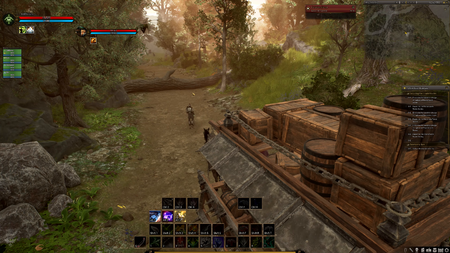
Our road system in-game is essentially driven by pre-placed routes that lead to this main artery of what was once the ancient highway system of Verra; and from there there are roads that become exposed when nodes advance; and we call those veins. They come off the main artery and then as nodes advance there are points of interest as Jeff was discussing earlier. These POIs that exist around the world and some of them share coverage with multiple nodes, but depending on which node advances to the stage that activates the point of interest it'll create these capillary roads so to speak that then stem off of the node itself. So you go from the main artery ancient road that's large- that runs through different zones and whatnot- and that breaks down into the veins that lead to the specific encampments and villages and towns that then spawn off separate capillaries that lead to the points of interest in these areas that are hunting grounds. Those are not exposed initially and they come online as players advance the world.[113] – Steven Sharif
As nodes advance, these pre-laid road spots that exist connecting every possible route between certain node structures is going to adjust and adapt, both its material presentation, the type of roadwork that's present: It'll move from dirt road type, to perhaps a brick road, to perhaps some super ornate beautiful metropolis style road that will adjust around the world according to how these node structures begin to populate and advance.[114] – Steven Sharif
Roads in Verra are both pre-generated and player influenced.[113]
- The largest roads are referred to as arteries. These are remnants of what was once the ancient highway system of Verra.[113]
- As nodes advance smaller roads, referred to as veins, connect the arteries to the nodes.[113]
- Depending on the stages of node advancement, capillary roads will stem off the node to connect to points of interest.[113]
- Roads or pathways are not worn into the landscape by repeated traffic over the same area.[113]
- The quality, safety, and maximum transportation speed of roads is influenced by node building upgrades, policies, relics, and the level of nearby nodes.[115][116][117]
- Q: Could you upgrade roads in the node to upgrade the roads and speeds of caravans?
- A: Absolutely. So that buff that you saw is a buff that can be changed in the world based on the world state. Some of those world state interactions include certain types of relics that the nodes which govern your area might have access to and might be actively employing. Some of it might have to do with policies: You might be able to extend the guard influences across the road radius further out for certain nodes if you have certain policies. You might be able to enhance and empower those guards through itemization choices that are granted by building upgrades that the node selects to build.[115] – Steven Sharif
Different seasons and events may affect access to various roads.[118][78][119][120]
- Pathways that are open during summer may be closed during winter.[118][120]
- Seasonal affects may cause obstacles or blockages to the transit of goods via caravan.[118][78][119][121]
- Caravan events can cause roadways to be blocked off or hostile mobs to spawn to attack the caravan.[112][78]
- Water turning to ice in winter, enabling players to walk over the water but blocking access to what is underneath.[120]
- Ice will make roads bumpy and slippery.[122]
Underrealm routes will open or close dynamically (based on node states).[123]
- The location of Underrealm entrances throughout the world is focused around natural geographic choke-points that exist above ground. This provides alternate subterranean routes that can be used by caravans, raids, and other player activities.[124][123]
- Not all entrances to the Underrealm will be open at the same time. This can shift dynamically (based on node states) that cause different routes to open up, which may be more or less advantageous than other routes.[123]
Caravan components can be utilized to improve on-road or off-road speeds of caravans.[125]
- You will travel faster over roads, but that obviously comes with the increased risk of running into other players or monsters that are blocking the road.[125] – Chris Justo
Freeholds may not be placed in close proximity to roads.[126]
Player housing
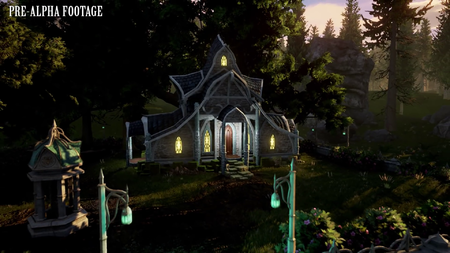
Players will have the ability to survey and develop land anywhere in the world. Be a pioneer deep in the wilderness, build the home of your dreams, and work the land to cultivate resources and supplies. Alternatively, stick with civilization and safety in numbers – purchase a home within the confines of a village and watch your investment grow as that village turns into a city. Homeowners in our game will have the ability to develop their plot of land as they see fit. Focus on farming, animal husbandry, or own your very own smithy. You’ll be able to specialize your land to maximize your profits or your comfort – be sure to choose wisely.[128]
Player housing is player-owned accommodation in the form of Apartments, Freeholds, Inns, and Static housing.[94][6]
A player may own up to one of each type of housing simultaneously.[130][131] Static housing and Apartments are one per server; Freeholds are one per account.[132]
| Player housing | Type. | Availability. | Starting count. | Limit. |
|---|---|---|---|---|
| Apartments | Instanced.[6] | Village stage and higher.[133] | 50.[134] | One per character per server.[132] |
| Freeholds | Open world.[6] | Village stage and higher.[6] | Low thousands per server.[135][136] | One per account.[132] |
| Inns | Instanced.[137] | Starting areas and Nodes.[94] | Most accessible.[94] | - |
| Static housing | In-node.[6] | Village stage and higher.[6] | 8.[134] | One per character per server.[132] |
- If you were to think about the level of exclusivity between the different types of housing that we have, obviously the most exclusive when it comes to a quantity is going to be Freeholds, followed by In-node housing, followed by Apartments, then followed by Inns.[138] – Steven Sharif
Trophy park
Trophy park is an area within Town, City or Metropolis nodes that has available spots for trophies. These trophies show the character names of players who are the first to complete world bosses and dungeon bosses that were spawned as the result of the development of that particular node.[139]
- Server announcements and achievements are designed to encourage groups to experience new content.[139]
Adaptive content

This is actually a dynamic POI. This one will evolve as players evolve the node that it's attached to. So this is its final state.[140] – Jeffrey Bard
New points of interest (such as dungeons, world bosses, and corrupted areas) spawn as nodes develop.[141][142] This content adapts to the node progression of the zone it is in.[140][143]
- Additional buildings will spawn.[140]
- Additional mobs will spawn.[140]
- Different antagonists/leaders with different story lines.[140][143]
- Populations will change.[143]
- Content difficulty will change.[143]
- The content may be different altogether.[143]
- Additional quest hooks.[140]
- Dungeons will be unlocked when certain nodes advance to certain stages.[144]
- Drop tables in areas and dungeons will be tied into the progression of certain areas.[144]
- POI events are events that relate to specific points-of-interest (POI).[147]
- The location of points of interest will be the same on each server, but some servers may have limited or no access to them.[148]
- Certain dungeons and other points of interest across the map will all be affected by the server’s node development. Some dungeons will only be unlocked if nodes are developed to certain stages. The storyline objectives for players inside dungeons will also be dependent on the story arc paths chosen through the node system. The drop tables in area and dungeons will also be tied into the progression of certain areas. For example, let’s say that the humans have developed a node in Region A, and a storyline has opened up that leads players to inspect the ruins (dungeon) of a nearby area. And let’s say that this node was developed in a scientific (crafting) zone… Well before the node developed, this dungeon was accessible… But now the dungeon has propagated new monster assets that include a drop table catering to a crafting emphasis because of the development of that academic node. And perhaps, a new boss appears in different rooms of the dungeon that includes different adventure quest starts, like a mysterious item with a storyline that can only be progressed if a node develops to the metropolis stage in a certain region, across the world. Our system is so vast, when it comes to interconnectivity and how the world reacts to the players.[144]
Corrupted areas
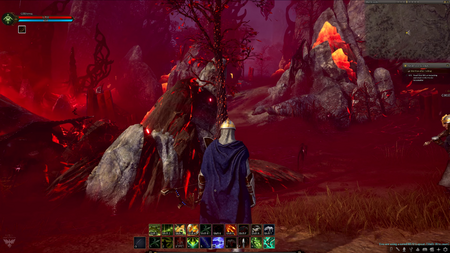
We just saw a corrupt zone and that zone becomes corrupt after a period of time in which players are not addressing some issues that arise through certain events or through certain story arcs; and that corruption can spread and corruption changes the spawners for resources and for monsters; and that has a fundamental effect on the resource economy of the game.[150] – Steven Sharif
Corrupted areas (zones/points of interest) can dynamically evolve with the progression of nodes and story arcs.[150][151][152][153][154][155][141]
- Harbingers that exist on Verra as dungeons are where The Ancients are capable of pushing into the material plane. They can continue to do so under the guise of the effects of corruption as it spreads.[156]
- These are sources of NPC events that players need to address before they grow out of hand.[150][105][155]
- Players need to participate in these events to stop the spread of corruption and hold back the intrusion on the material plane.[150][156]
- If players fail to address these corrupted areas, the frequency of NPC events against their node will increase. These can lead to node buildings and services being disabled, increasing the node's vulnerability to node sieges.[157]
- It can be a very detrimental thing if corruption is not addressed; and that's the intent of corruption, is to present a challenge to the players that if not addressed it becomes exacerbated and a problem over time.[157] – Steven Sharif
- Corrupted areas do not confer corruption onto a player. Only PvP related activities lead to player corruption (in the flagging system).[158][159]
- To degree your mortal coil, as we call it, or what some might consider a soul from your character's perspective within this story- can be influenced and can be changed into a shape that's more in tune with corruption; and that's through doing PvP things you can accomplish that.[158] – Steven Sharif
- When it enters the corruption state outside of weather, in that corrupt state, you will probably see a little bit less of the influence of the season because really it's adopting that corruption, which in-and-of-itself is a season.[160] – Steven Sharif
- Corrupted areas will spawn variations of mobs and resources.[150]
- Corrupted resources are only available in corrupted areas or during certain story arcs.[150][151][161][162][163]
See also
References
- ↑ Video, February 29, 2024 (33:57).
- ↑ 2.00 2.01 2.02 2.03 2.04 2.05 2.06 2.07 2.08 2.09 2.10 2.11 2.12 Blog - Know Your Nodes - Advance and Destroy.
- ↑ 3.0 3.1 3.2 3.3 A reactive world - Nodes.
- ↑ Video, April 20, 2017 (0:02).
- ↑
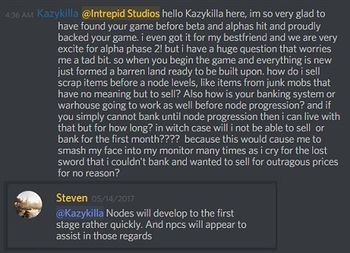
- ↑ 6.0 6.1 6.2 6.3 6.4 6.5 6.6 Node series part II – the Metropolis.
- ↑ 7.0 7.1 Livestream, October 16, 2017 (50:20).
- ↑ 8.0 8.1 8.2

- ↑ 9.0 9.1 9.2 9.3

- ↑ Livestream, February 29, 2024 (53:58).
- ↑ 11.0 11.1 11.2 Interview, July 18, 2020 (10:04).
- ↑ 12.0 12.1 12.2 12.3 12.4 12.5 Interview, July 8, 2020 (1:00:15).
- ↑
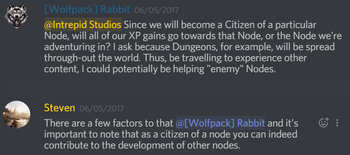
- ↑ Livestream, September 24, 2021 (1:21:23).
- ↑ 15.0 15.1 Livestream, May 26, 2017 (28:16).
- ↑ 16.0 16.1 16.2 16.3 16.4 Livestream, October 14, 2022 (55:13).
- ↑ Livestream, November 17, 2017 (55:27).
- ↑ 18.00 18.01 18.02 18.03 18.04 18.05 18.06 18.07 18.08 18.09 18.10 18.11 18.12 Blog - Know Your Nodes - The Basics.
- ↑ Livestream, December 12, 2018 (14:48).
- ↑ Interview, July 20, 2020 (3:45).
- ↑ 21.0 21.1 21.2 21.3 Livestream, August 26, 2022 (1:07:34).
- ↑

- ↑ Livestream, August 31, 2023 (52:56).
- ↑ 24.0 24.1 Livestream, August 26, 2022 (1:04:35).
- ↑

- ↑ 26.0 26.1 26.2 26.3 26.4 Livestream, August 26, 2022 (1:10:16).
- ↑ Interview, July 19, 2020 (19:35).
- ↑ Livestream, May 15, 2017 (30:53).
- ↑ Livestream, August 26, 2022 (1:28:50).
- ↑ Interview: Ashes of Creation on Building Their Virtual World, 2017-04-13.
- ↑ 31.00 31.01 31.02 31.03 31.04 31.05 31.06 31.07 31.08 31.09 31.10 Livestream, September 24, 2021 (30:26).
- ↑ Interview, July 19, 2020 (1:10:55).
- ↑ Livestream, October 14, 2022 (57:22).
- ↑ 34.0 34.1 34.2 34.3 Interview, July 19, 2020 (1:08:22).
- ↑ 35.0 35.1 35.2 Livestream, June 4, 2018 (39:15).
- ↑ Video, January 27, 2023 (16:44).
- ↑ 37.0 37.1 Interview, July 18, 2020 (27:11).
- ↑ Livestream, May 24, 2017 (44:14).
- ↑

- ↑ Interview, September 10, 2023 (53:47).
- ↑ Livestream, March 26, 2021 (1:07:33).
- ↑

- ↑ Podcast, May 5, 2017 (43:05).
- ↑

- ↑ Livestream, May 3, 2017 (35:25).
- ↑ Interview, July 18, 2020 (1:00:15).
- ↑ Ashes of Creation Forums - Former Lineage 2 PvP'er wanting to discuss PvP loopholes.
- ↑ 48.0 48.1 Interview, July 19, 2020 (8:43).
- ↑ February 8, 2019 - Questions and Answers.
- ↑ Interview, July 20, 2020 (21:57).
- ↑ Livestream, 2018-04-8 (PM) (55:49).
- ↑ 52.0 52.1 Livestream, July 25, 2020 (46:08).
- ↑ Livestream, December 22, 2020 (1:15:01).
- ↑ Livestream, May 27, 2022 (1:14:46).
- ↑ Video, May 27, 2022 (2:21).
- ↑ 56.0 56.1 Livestream, February 29, 2024 (1:22:09).
- ↑ Podcast, August 4, 2018 (1:44:54).
- ↑ X.com - Fly on through the Village Node we showed in our August livestream!
- ↑ Node series part I
- ↑ 60.0 60.1 Blog: 10 facts about castle sieges in the MMORPG.
- ↑ 61.0 61.1
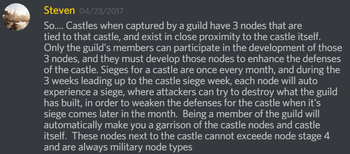
- ↑ 62.0 62.1 Podcast, April 23, 2018 (15:14).
- ↑ 63.0 63.1 Livestream, August 26, 2022 (1:05:47).
- ↑ Interview, August 24, 2018 (3:44).
- ↑ Livestream, August 26, 2022 (1:18:54).
- ↑ Livestream, August 26, 2022 (1:06:42).
- ↑ 67.0 67.1 Livestream, November 30, 2020 (37:16).
- ↑ Livestream, October 31, 2023 (1:34:37).
- ↑ Livestream, May 17, 2017 (55:40).
- ↑ 70.0 70.1 70.2 Livestream, October 30, 2020 (39:17).
- ↑ 71.0 71.1 71.2 71.3 71.4 71.5 Livestream, September 27, 2018 (53:06).
- ↑ 72.0 72.1 Livestream, February 25, 2022 (41:00).
- ↑ 73.0 73.1 Livestream, February 26, 2021 (1:12:18).
- ↑ 74.0 74.1 74.2 74.3 74.4 74.5 Livestream, March 31, 2022 (4:57).
- ↑ Podcast, April 11, 2021 (29:47).
- ↑ Interview, May 11, 2018 (54:34).
- ↑ Livestream, May 26, 2017 (21:23).
- ↑ 78.0 78.1 78.2 78.3 Podcast, April 11, 2021 (23:36).
- ↑ 79.0 79.1 Interview, May 11, 2018 (47:27).
- ↑ 80.0 80.1 Livestream, July 29, 2022 (1:13:09).
- ↑ Livestream, June 26, 2020 (45:32).
- ↑ 82.0 82.1 Interview, February 7, 2021 (33:00).
- ↑ 83.0 83.1 Interview, May 11, 2018 (1:00:19).
- ↑ 84.0 84.1 Podcast, April 23, 2018 (29:56).
- ↑ 85.0 85.1 Interview, July 9, 2023 (1:35:28).
- ↑ 86.0 86.1 86.2 86.3 86.4 86.5 86.6 86.7 Video, August 31, 2023 (28:04).
- ↑ Livestream, March 28, 2020 (1:03:38).
- ↑

- ↑

- ↑ Interview, July 9, 2023 (54:46).
- ↑ Livestream, June 30, 2023 (1:45:22).
- ↑ 92.0 92.1

- ↑ Blog: Development Update with Village Node.
- ↑ 94.0 94.1 94.2 94.3 Livestream, August 31, 2023 (15:51).
- ↑ 95.0 95.1 Interview, July 9, 2023 (38:14).
- ↑ 96.0 96.1 Interview, March 27, 2020 (0:30).
- ↑ Video, April 5, 2018 (41:48).
- ↑ Livestream, September 29, 2023 (1:11:22).
- ↑ 99.0 99.1 Interview, May 11, 2018 (57:02).
- ↑ Types of Events on Verra.
- ↑ Livestream, April 29, 2022 (32:29).
- ↑ 102.0 102.1 102.2 102.3 102.4 102.5 102.6 102.7 102.8 Livestream, April 29, 2022 (42:31).
- ↑ 103.0 103.1 103.2 103.3 103.4 103.5 Livestream, May 4, 2018 (48:14).
- ↑ Livestream, April 29, 2022 (39:00).
- ↑ 105.0 105.1 Livestream, June 25, 2021 (1:13:30).
- ↑ 106.0 106.1 106.2 106.3 Interview, August 17, 2018 (24:48).
- ↑ Interview, March 27, 2020 (16:19).
- ↑

- ↑ Livestream, May 22, 2017 (40:40).
- ↑ 110.0 110.1 110.2 110.3 Livestream, April 30, 2021 (1:01:10).
- ↑ 111.0 111.1 Livestream, October 30, 2020 (1:01:00).
- ↑ 112.0 112.1 112.2 Video, October 31, 2023 (34:12).
- ↑ 113.0 113.1 113.2 113.3 113.4 113.5 Livestream, January 29, 2021 (1:13:04).
- ↑ 114.0 114.1 Livestream, January 28, 2022 (33:25).
- ↑ 115.0 115.1 Livestream, October 31, 2023 (1:16:34).
- ↑ Video, October 31, 2023 (28:06).
- ↑ Livestream, February 9, 2018 (45:48).
- ↑ 118.0 118.1 118.2 118.3 Video, May 27, 2022 (15:50).
- ↑ 119.0 119.1 Livestream, June 26, 2020 (1:29:06).
- ↑ 120.0 120.1 120.2 120.3 Livestream, May 8, 2017 (20:27).
- ↑ Our immersive world - Environments.
- ↑

- ↑ 123.0 123.1 123.2 Livestream, October 30, 2020 (1:19:13).
- ↑ Livestream, August 26, 2022 (53:26).
- ↑ 125.0 125.1 Video, October 31, 2023 (20:17).
- ↑ Livestream, May 19, 2017 (32:23).
- ↑ Video, May 25, 2017 (1:07).
- ↑ About Ashes of Creation.
- ↑ Livestream, May 4, 2018 (32:46).
- ↑ Interview, July 9, 2023 (42:11).
- ↑

- ↑ 132.0 132.1 132.2 132.3 Interview, May 11, 2018 (50:47).
- ↑ Steven Sharif - Clarification points from today’s stream.
- ↑ 134.0 134.1

- ↑ Blog: Exploring the Boundless Opportunities of Freeholds.
- ↑

- ↑ Livestream, August 31, 2023 (22:32).
- ↑ Livestream, August 31, 2023 (18:13).
- ↑ 139.0 139.1 Podcast, August 4, 2018 (1:35:58).
- ↑ 140.0 140.1 140.2 140.3 140.4 140.5 140.6 Livestream, March 26, 2021 (50:33).
- ↑ 141.0 141.1 Livestream, March 26, 2021 (22:53).
- ↑ Livestream, November 17, 2017 (36:22).
- ↑ 143.0 143.1 143.2 143.3 143.4 Livestream, November 17, 2017 (18:29).
- ↑ 144.0 144.1 144.2 144.3 MMOGames interview, January 2017
- ↑

- ↑

- ↑ Livestream, April 29, 2022 (40:21).
- ↑
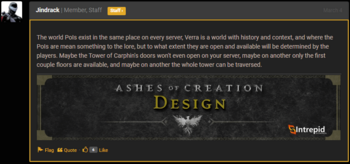
- ↑ Video, November 30, 2023 (29:26).
- ↑ 150.0 150.1 150.2 150.3 150.4 150.5 Video, November 30, 2023 (32:36).
- ↑ 151.0 151.1 Interview, July 9, 2023 (47:05).
- ↑
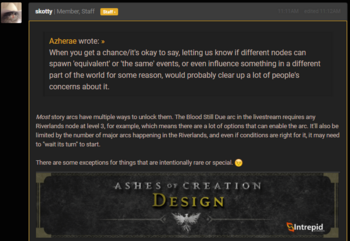
- ↑ Video, March 31, 2023 (1:22).
- ↑ Video, March 31, 2023 (3:32).
- ↑ 155.0 155.1 Livestream, March 26, 2021 (50:03).
- ↑ 156.0 156.1 Livestream, November 8, 2020 (12:47).
- ↑ 157.0 157.1 Livestream, January 28, 2022 (1:17:12).
- ↑ 158.0 158.1 Livestream, March 31, 2023 (54:22).
- ↑ Livestream, June 25, 2021 (1:32:24).
- ↑ 160.0 160.1 Livestream, March 31, 2023 (58:27).
- ↑ Livestream, March 31, 2023 (59:10).
- ↑ Video, March 31, 2023 (16:42).
- ↑
